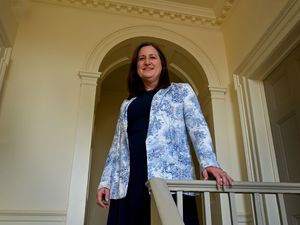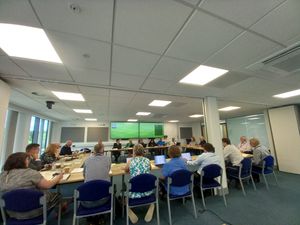Meet the Shropshire architect behind the Olympic Stadium
He is the brains behind some of world's most impressive stadiums – and today farmer's son Tom Jones, has revealed how winning a competition in the Shropshire Star as a teenager inspired him to a career in architecture.

He is the brains behind some of world's most impressive stadiums – and today farmer's son Tom Jones, has revealed how winning a competition in the Shropshire Star as a teenager inspired him to a career in architecture.
The 41-year-old, who is originally from Westbury near Shrewsbury, masterminded the 80,000 seat Olympic Stadium in London and also helped deliver Arsenal's £390 million Emirates Stadium, which opened in 2006.
He has also worked on major stadiums overseas including the Viv Richards Stadium in Antigua – which was built to host matches for the 2007 ICC Cricket World Cup.
Today he revealed his first step into the field came in 1985, when he was named Shropshire Star's Young Designer of the Year after entering a competition to come up with property of the future.
"It was a competition to design a house for the year 2000 and it was the first time I have ever done any sort of architectural design," he said.
The former Mary Webb School pupil said he had come up with an eco-friendly design including solar panels.
"In some ways, it wasn't too far off the reality," he said.
The move inspired him to pursue an interest in architecture and after training in Cardiff, Mr Jones has ended up as a principal in charge of business design at London firm Populous.
Since then his design credits have included the Theatre Royal in Gibraltar and the Zanadu Snow Centre in Taiwan.
He was also worked with American Football bosses to help stage two Super Bowls in Miami and Dallas.
Other projects have included the Brighton Dome and Museum in the UK and master planning of the National Museum of the American Indian in Washington DC.
His last few years of work have been focused on leading the mammoth Olympic Stadium project.
He attended the opening and closing ceremonies with his parents Lloyd and Jill, who still live in Shropshire, as well as wife Debbie and oldest son Luke, four.
Mr Jones and his family were also there for the morning session of Super Saturday which saw Team GB collect three athletics golds.
He said it was a proud moment to see the site in operation.
He said: "We had a wonderful time at the Olympic Stadium on the morning of Super Saturday.
"It was very special for me to be able to take mum and dad, as well as Debs and Luke to the stadium and to see how it worked in practice after having spent so many years working on the design," he said.
"We were lucky enough to see Jessica Ennis compete in the long jump and javelin, as well as Usain Bolt running in the first heats of the 100 metres. The atmosphere was electric as Jess competed in her events and it was incredible to hear the noise of the spectators when Bolt ran his 100 metres."
He added the incredible atmosphere within the stadium could partly be put down to how it was designed.
"We had spent a lot of time trying to design a seating bowl that would get the spectators as close to the running track as possible, in order that we could create a special connection between the athletes and the spectators during the athletic events," he said.
"I met Lord Coe a couple of years ago on one of his visits to the stadium and asked him which was the best stadium that he had competed in. He said it was the Bislett Stadium in Oslo, because of the 'wall of noise' that greeted athletes as they ran around the track," he said.
"What was special for me was to see the way in which a 'Mexican wave' of noise followed the athletes around the London Olympic Stadium – reaching a crescendo as they ran down the final straight. I can only imagine what it must have been like to watch Mo Farah winning his gold medals."
He said years of hard work had gone into planning the stadium.
"We probably had about 50 architects involved in the process, with a team of 25 at its peak," he said.
"The first challenge going into the project was the time and when we started work there were a number of issues with projects like Wembley, in terms of finishing on time."
Mr Jones said the team also had to find a way to follow on from the famous Bird's Nest stadium used for the 2008 Olympics in Beijing.
"It was the same challenge for the opening ceremony.
"They had unlimited use of resources and we had to try and do something a little different."
He said organisers had focused on making the stadium eco-friendly, using just 10 per cent of the amount of steel that went into creating the Bird's Nest, as well as ensuring its size can be reduced after the Games has finished.
"It was designed to be demountable. The original design was for 80,000 to reduce to 25,000. It was a question of how do you design something so big that can be reduced?
"We used lots of light-weight materials, which are built together like a Meccano kit. It was all built so we could take it down afterwards.
The more likely scenario now is it will be reduced to about 60,000."
Mr Jones' work has seen him travel the globe and one of his major clients is the National Football League in America.
The architect and his team have helped to mastermind several Super Bowl events, which have been watched by millions of Americans.
But Mr Jones said Danny Boyle's Olympic opening ceremony put the Super Bowl in the shade.
He said: "Until I saw the opening ceremony I thought the Super Bowl was the best event I had ever seen. But the London opening ceremony was incredible."
Following his amazing achievement designing the Olympic stadium in London, it is back to the drawing board for the architect.
Rather than taking a well-earned break, he has already begun work on his next major project – masterminding the creation of a new stadium in Sotchi, Russia, ahead of the Winter Olympics in 2014. "A lot of what we do is a few years ahead, so we are half way through the Russia project at the moment, he said.
He is also part of the design team drawing up plans for a new 35,000-seater stadium for Premier League side Queens Park Rangers.
The club's current Loftus Road home is the smallest group in the top flight with a capacity of 18,439.
Despite his incredible career, which has seen him travel the world, Mr Jones said he still very much considers himself a Shropshire lad.
"I've still got my trophy from the Shropshire Star competition at home, and all my family are from the county," he said.




